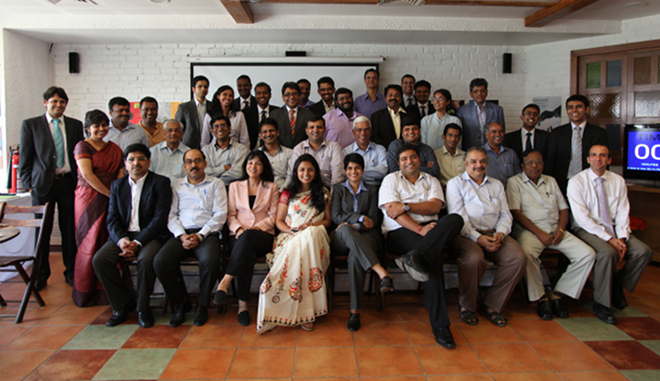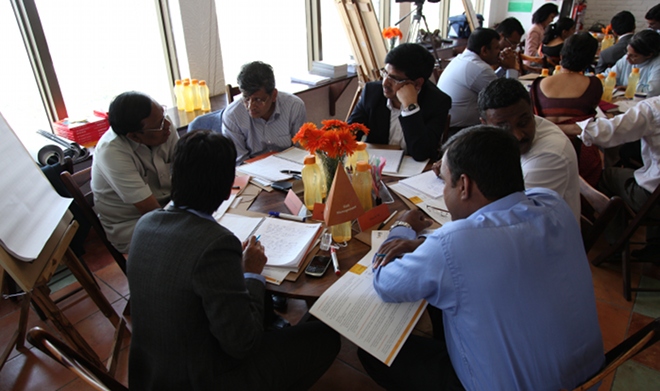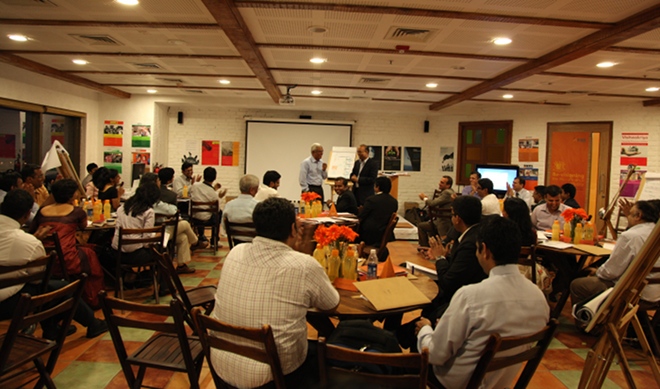
On November 22nd and 23rd, IFMR Capital held its first partners meet, a two day meet with all its partners to re-envision access to finance for institutions that impact low income households. Industry participants and researchers came together to discuss a broader vision for the industry. While the two day event saw active participation and debate on issues that currently concern the sector, the emphasis of the meet was largely on the way forward. Held at a critical juncture, participants brainstormed and discussed strategies for reshaping the sector towards a shared vision.
The meet followed the appreciative inquiry format and drew out the best from the participants. The first part was designed to shift the focus of participants from being short-term reactive to long-term proactive. The second part focused on the positives of the industry and on what was valuable about the way the sector has functioned in the past. The participants broke into groups of two and interviewed each other. Each person described their high points and success stories, sharing instances of how and why being in this sector made them feel glad they belonged here.

The third part of the approach sought to use the output from the interviews to get a clear sense of what were the most important factors that contributed to the success in the sector. Later, organised in groups of six, participants worked on a vision of what the sector would be like in five years if the root causes of success were leveraged in specific areas of focus such as governance, customer focus, risk management, product development, etc. The end result was a shared vision that institutions in the sector could look up to.

Some important questions that emerged during the meet are listed below:
- How should we position MFIs so that they become an indispensable part of the financial system?
- How do we engage with the political groups more effectively?
- What are the unique and additional responsibilities of MFI boards, given that they deal with a segment that is financially and otherwise excluded?
- As a sector, what data do we need to collect and disseminate, internally and externally, to enable holistic risk management?
- What investments in training will organizations and the industry make in:
- Moving from mono-line to a multi product model
- Ensuring common minimum values are shared across the sector
- Taking on the new role of a financial advisor
- How do we use technology or other disruptive methods to dramatically improve operating efficiencies?
- What is the regulatory framework which will allow MFIs to flourish and serve a wider range of financial needs?
- How do we resolve short-term funding & liquidity issues for the sector?
In the last part of the meet, the groups focused on developing tactical strategies on four areas : brand management, product development, political engagement and ensuring common minimum values, areas that needed immediate action to take the industry from where it is today to where the group would like to see it in the future.

Here is a brief summary of the themes that emerged from the meet.
a) Customer centric approach: The MFI industry’s main strength is its ability to reach out to and serve a vast number of clients. Client engagement is continuous and services provided are valuable. There was a clear consensus that going forward this customer centric approach must continue to be of key importance.
b) Innovation: Every growing sector continuously evolves. Institutions must be able to respond to the changes in the sector. The need is for an innovative and flexible approach which ensures sustainability and works in the interest of its end customers. The idea of MFIs offering multi-products was discussed at length. This was the way forward and MFIs must invest time, effort and capital towards this. MFIs already possess large amounts of granular financial data pertaining to their clients. This could help them understand the needs and capacities of their clients better and in turn aid the design of relevant financial products.
c) Operating efficiencies: The cost to serve low income households can potentially be dramatically reduced by disruptive innovations. Key pieces of infrastructure such as the UID have the potential of making KYC a public good. Enormous strides in technology such as the use of biometric identification, automated payment systems, mobile technology with improved authentication through the UID can also ensure that local branch staff leverages technology to perform their most repetitive day-to-day tasks, freeing up their time to perform their core duty of understanding the needs of clients and recommending appropriate solutions. There was a clear consensus that business models need to evolve and leverage such innovations.
d) Importance of the mission: While sustainability of business was crucial, it was agreed that the commitment to social and economic well-being of the client was crucial to the sector. Given the profile of the average client, MFIs perform the important role of giving access to finance to the most excluded segment of society. Going forward, organizations must not lose sight of this fact. Further, it is necessary that there is an alignment of objectives and vision across the entire company.
e) Positioning of the industry: Concerns were raised about the response of the industry to the recent crisis and the lack of a unified voice. The role of the board was stressed in this respect, many felt that the board should play a role in ensuring customer metrics are tracked continuously and senior management is held accountable to performance as measured against the metrics. This would also ensure that MFIs are collecting enough information during good times as well as bad, so an accurate picture can be presented to the media, investors and regulators.
f) Holistic risk management: The current business model of organisations in the inclusive finance sector is strong on operations and therefore manages operations related risks very well. However, in order to evolve into universal financial service providers, organisations need to focus on risk in a more holistic manner, ie look at all aspects of risk such as operational risk, credit risk, interest rate risk, liquidity risk, political and regulatory risk. Capacities need to be built internally, for instance, risk departments need to be set up, people need to be hired and adequate training needs to be provided, investment needs to be made in risk management systems. However, it was agreed that senior management buy-in was critical to the implementation of “holistic risk management”.


One Response
Mr. Ghosal, thanks for your comment. Most of the large MFIs are NBFCs and there are several restrictions on bank (equity) investments in NBFC that make the subsidiary model challenging.